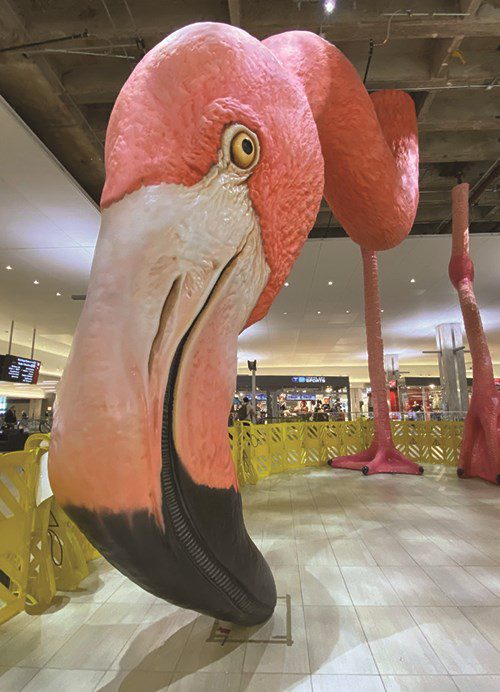People are flocking to see the newest art installation at Tampa International Airport (TPA)—the larger-than-life flamingo sculpture in a primary pre-security circulation area of the Main Terminal. For some, the genius of Home by Matthew Mazzotta is more about what it doesn’t depict than what it does. Only the flamingo’s spindly legs, webbed feet, and brightly colored head and neck are visible, as if airport guests are underwater as the giant bird dips down to find food.
People are flocking to see the newest art installation at Tampa International Airport (TPA)—the larger-than-life flamingo sculpture in a primary pre-security circulation area of the Main Terminal.
For some, the genius of Home by Matthew Mazzotta is more about what it doesn’t depict than what it does. Only the flamingo’s spindly legs, webbed feet, and brightly colored head and neck are visible, as if airport guests are underwater as the giant bird dips down to find food. Metal panels and shifting light patterns in the ceiling complete the immersive effect.
The long-awaited artwork has garnered widespread attention since the airport released a preliminary rendering in February 2020. In fact, TPA’s marketing staff fielded more inquiries about the sculpture than any other topic last year—more than COVID measures, changes in flight service, etc.
“Tampa International Airport has always been a champion of iconic public art as a way to welcome our visitors and give them a sense of wonder and whimsy when they arrive in our beautiful region,” says Vice President of Marketing and Communications Chris Minner. “We’re certain that Home will help create memories and inspire people of all ages who begin and end their travel journeys at TPA.”

Mazzotta designed his hand-sculpted resin and fiberglass artwork so airport guests can physically interact with it. There will be no velvet ropes keeping viewers at bay, and no Do Not Touch signs.
TPA officials hope that Mazzotta’s flamingo will prove to be as iconic as the red rabbit at Sacramento International or the giant teddy bear at Hamad International in Doha, Qatar. Given the intense interest the new sculpture has already garnered, it looks like Home is well on its way to doing just that.



